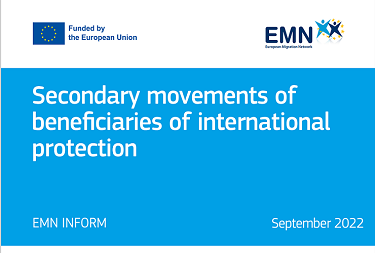EMN study on secondary movements of beneficiaries of international protection (migrants with asylum status). These are beneficiaries of international protection who move to an EU member state other than where they were granted international protection.
Study: Secondary movements of beneficiaries of international protection
The study mostly covers the transfer of responsibility for a beneficiary of international protection between Member States. This transfer determines, for example, which Member State is responsible for issuing travel documents for refugees such as a Convention Passport.
EMN Study: 'Secondary movements of beneficiaries of international protection´
Research Period - 2022
Participating countries - Belgium (BE), Cyprus (CY), Germany (DE), Estonia (EE), Finland (FI), France (FR), Greece (EL), Hungary (HU), Ireland (IE), Italy (IT), Latvia (LV), Lithuania (LT), Luxembourg (LU), Netherlands (NL), Austria (AT), Poland (PL), Portugal (PT), Slovakia (SK), Spain (ES), Czech Republic (CZ), Sweden (SE)
Motivation and scope

Secondary movements of status holders has so far received little attention from politicians, researchers and governments. This study provides an overview of Member States' national and international regulations on the transfer of responsibility for a beneficiary from the first State to the Second state. It also explores the situation where beneficiaries, already recognised in a first State, lodge applications for international protection in a second State. The scope of the Inform includes all persons who have been granted refugee status or subsidiary protection, and are present in the territory of a second State for the following reasons:
- They hold a residence permit (e.g. on the basis of employment, education/study, etc.);
- They stay without authorisation;
- They make a further application for asylum.
Dublin transfers fall outside of the scope of this study.
Research questions
- What is the legal framework in your Member State which applies for the transfer of responsibility for beneficiaries of international protection?
- What are the legal consequences of the transfer of responsibility for the individual Member States and what does this mean for administrative practice?
- What challenges do Member States face with regard to the transfer of responsibility?
- To what extent have such cases occurred in the Member States in recent years?
- What are the consequences of recent European case law and legislation for the Member States for such cases?
- How do Member States deal with asylum applications from already recognised beneficiaries of international protection?
Publications EMN
- EMN Inform 'Secondary movements of beneficiaries of international protection´ (pdf), 30 September 2022
Publications EMN Netherlands
- News item (with summary): 'Uniform EU legal framework regarding the transfer of responsibility for beneficiaries of international protection is lacking', 24 October 2022


